Latest News
August 16, 2011
By Mark Freebrey
The volatile nature of fuel prices has forced the aerospace industry to make weight reduction a high-priority focus. Reducing the weight of aircraft seating significantly reduces aviation fuel consumption and carbon dioxide emissions throughout the operational lifetime of the aircraft, with every bit of weight contributing to the running costs of an aircraft to the carrier.
DeltaCAD Ltd was founded in Devon, England, in 2010 by Dean Challis, a design engineer with considerable CAD/CAM and tool design experience. It provides a comprehensive range of design and manufacturing services, from 2D drawings to 3D modeling and CAM programming.
For this project, the original CAD model was provided by the customer as a Unigraphics NX file. The part analysis and tool design was performed using VISI Modeling from Vero Software.
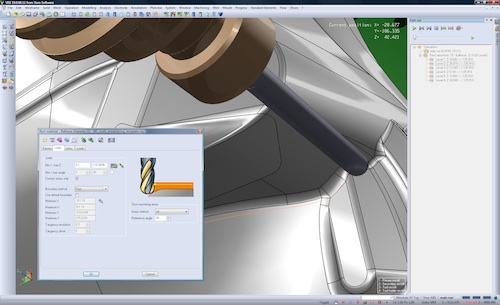
All toolpaths were created using VISI Machining.
“VISI is very tolerant of non-native data,” Challis points out. “Often, when models are originally designed, the manufacturing requirements are not always known. To make a part manufacturable, it is vital to interact with the data and make the relevant changes.”
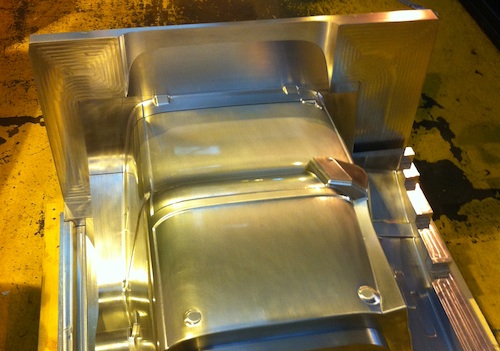
Aluminum tooling for carbon fiber seat shell.
With authority from the original design team, the tooling was modified to remove undercut areas and apply blend radii on sharp edges, he says, adding, “Typically, blending can be a very complex task “and it is often necessary to explode a model into surfaces and manually apply the CAD modifications. VISI is very strong at switching between a solid and surface environment, and this allows us to make complex changes where other CAD systems often fall over.”
The manufacture of the tooling was performed by Casting Support Systems Ltd, a company that supplies large tooling to the investment casting, plastic molding and gas turbine industries. In conjunction with its sister company Versa-tote, Casting Support Systems is also a forerunner in the design and manufacture of returnable transit boxes, picking and order tote boxes for distribution and storage facilities across Europe.
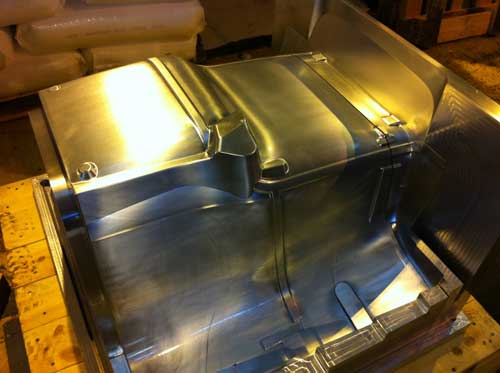
Aluminum tooling for carbon fiber seat shell.
All toolpaths were programmed using VISI Machining. The aluminum tooling was milled using XYZ 1060 high-speed vertical machining centers running Siemens’ 840D ShopMill Control, with WNT solid carbide end mills that have been specifically designed for cutting softer materials such as aluminum. The geometry of the tooling makes it possible to cut full slots to 1.5xD depth with high feed rates “typically twice that of traditional steel cutting tools. The tooling life for the cutters is approximately 3,000 hours.
The entire multi-surface tool was manufactured and assembled in just nine days. This occurred in part because of optimal toolpath usage and running multiple jobs at the same time.
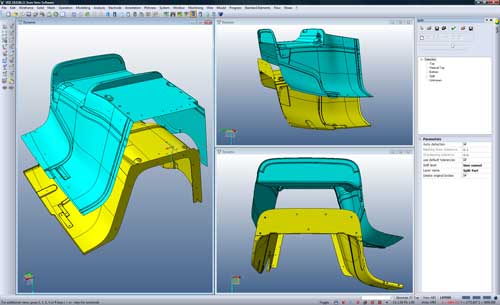
Original CAD model, split into core and cavity surface groups.
“Complex tools often contain a number of sub-inserts, where the setup time is disproportionate to the actual CAM runtime,” explains Sam Cox, tool room foreman at Casting Support Systems. “To overcome this obstacle, we set up a number of individual jobs located around a single datum, which run overnight for lights-out machining. Although the machine can run at optimum production rates, we back off when running overnight to protect tool life. We use VISI to accurately predict the actual toolpath cutting time, and program accordingly. A typical set of overnight programs will run for up to 14 hours.”
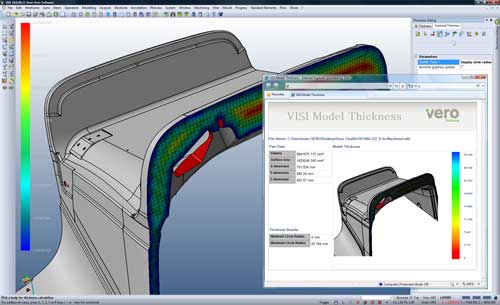
Model thickness performed using VISI Analysis.
The carbon fiber material used was a 2x2 twill weave cloth that is pre-impregnated with epoxy resin so that when the tool is brought up to temp (120 °F to 140 °F, depending on the resin used), the resin cures within approximately one hour. The tool is then cooled as quickly as possible and the top half of the tool is removed, exposing the carbon fiber molding. The properties of carbon fiber, such as high tensile strength, low weight, and low thermal expansion make it very popular in aerospace, civil engineering, military, and competition sports.
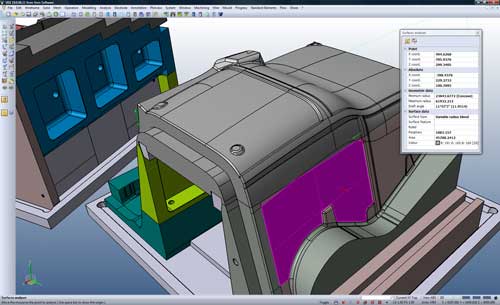
3D tooling designed using VISI Modeling.
The complete assembled, multi-insert tooling was sent to the customer for lay-up and production, where the final carbon fiber component (measuring 700x680x460mm) weighed only 5.25 lbs. and was “right the first time, having virtually no visible split line definition.”
Although Casting Support Systems already has in-house CAD/CAM capabilities, Director James Head acknowledges the benefits of using external design expertise from DeltaCAD and maximizing the use of VISI Machining.
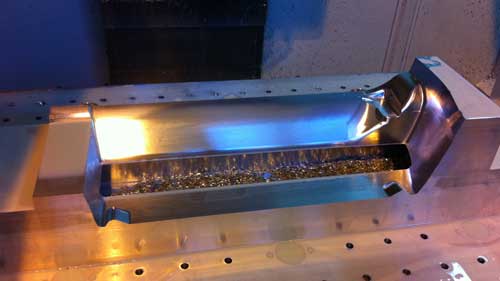
Aluminum insert machined using specialized WNT tooling.
“The combination of Dean and VISI has catered for many additional requirements, and has in fact exceeded our expectations,” he says. “Vero has provided a powerful, cost-effective solution for the design and manufacture of complex tooling.”
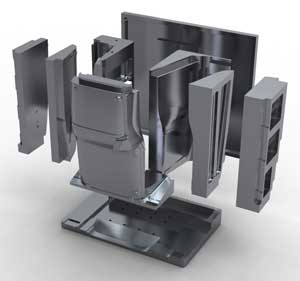 More Info:
More Info:
DeltaCAD Ltd
Casting Support Systems Ltd
Siemens
Vero Software
WNT Europe
Subscribe to our FREE magazine, FREE email newsletters or both!
Latest News
About the Author
DE’s editors contribute news and new product announcements to Digital Engineering.
Press releases may be sent to them via [email protected].






